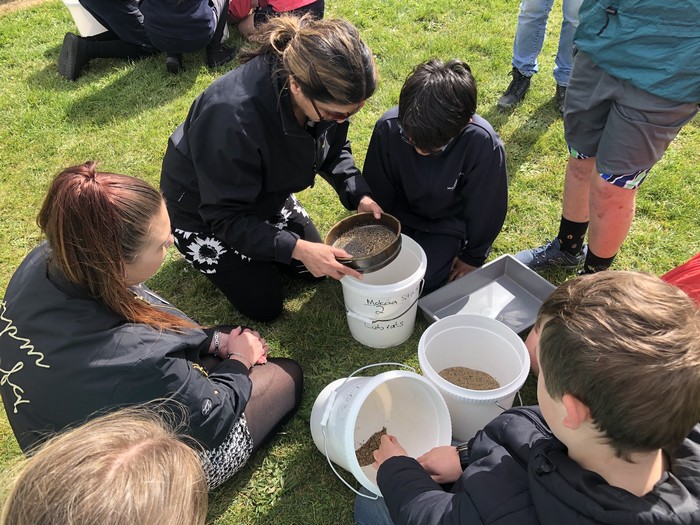Microplastic sampling from lake to sea

Students from Mokoia Intermediate, Whangamarino and Maketu Schools in the Bay of Plenty have something in common. They are all close to water bodies that take freshwater from Lake Rotorua to the sea, and they all took part in a Scion-led project working to study microplastics in the Kaituna catchment.
Awareness of New Zealand’s microplastic pollution issues is growing, helped along by biomaterial researchers Dr Meeta Patel, Dr Kate Parker and Jamie Bridson. They observed New Zealand’s microplastics problem first-hand when sampling the sand and soil around Auckland waterways. The findings spurred them into further action and led to this project examining the microplastics present in our Bay of Plenty backyard.
Sampling soil and sand
The project began with Scion’s microplastic experts Meeta, Jamie and Kate visiting each school. Students then took to the field to sample a section of sand.
Mokoia Intermediate School sampled the beach on the eastern edge of Lake Rotorua at Hannah’s Bay. Downstream, a few kilometres away on the banks of the Kaituna River (outlet for Lake Rotorua) is where Whangamarino School carried out their sampling. Maketu School, at the end of the river’s journey, took samples at Maketu beach.
The next step was finding out what their samples held. Students used sieves to separate microplastics from the sand, and then applied a simple density separation method to identify what kinds of plastic they found. Their bounty included the most common types of plastic (PP, PE, PS and PET). After analysing the microplastic samples, students wrote reports and gave presentations on what they found.
Teachers and students
On sampling day, Mokoia student Lachie Hoggard admitted that it’s easy to forget rubbish you can’t see. He was inspired to take action and recommended that people should try to buy food with more ecofriendly packaging and remember to bring their own bags to the supermarket.
Krystal Stevenson, science teacher at Mokoia Intermediate School, said that students gained a lot from this approach and from learning outside the classroom. “Most of our students know about microplastics from school or home. Now they know much more and what they can do to make a difference.”
The project was also fortunate to have support from Tatau Pounamu, a communityled organisation running environmental, health and wellbeing initiatives in Rotorua’s eastern suburbs. Tireni Ratema, Pou Tāhu at Tatau Pounamu, helped Mokoia students with sampling and provided a cultural lens to the project. “Strengthening the student’s sense of identity and connection to the whenua is important,’ says Tireni. “With that knowledge, our tamariki will be better equipped to navigate the future. A connection to land gives you substance, defines your uniqueness and provides a roadmap for wellbeing.”
At the end of the day
Meeta says, “Microplastics have been found everywhere from Antarctica to the deepest trenches of the Pacific Ocean¹ so we weren’t surprised to find them in the Kaituna catchment. By talking to our students about the issues, we’ve raised their awareness of how microplastics get into waterways and the damage they can cause.
“For the kids, it’s empowering. They understand that through their strong sense of katiakitanga (stewardship) for their lakes and rivers, they’re helping to look after the people and environment downstream.”
This project was supported by the Ministry of Business, Innovation and Employment’s Unlocking Curious Minds fund.
